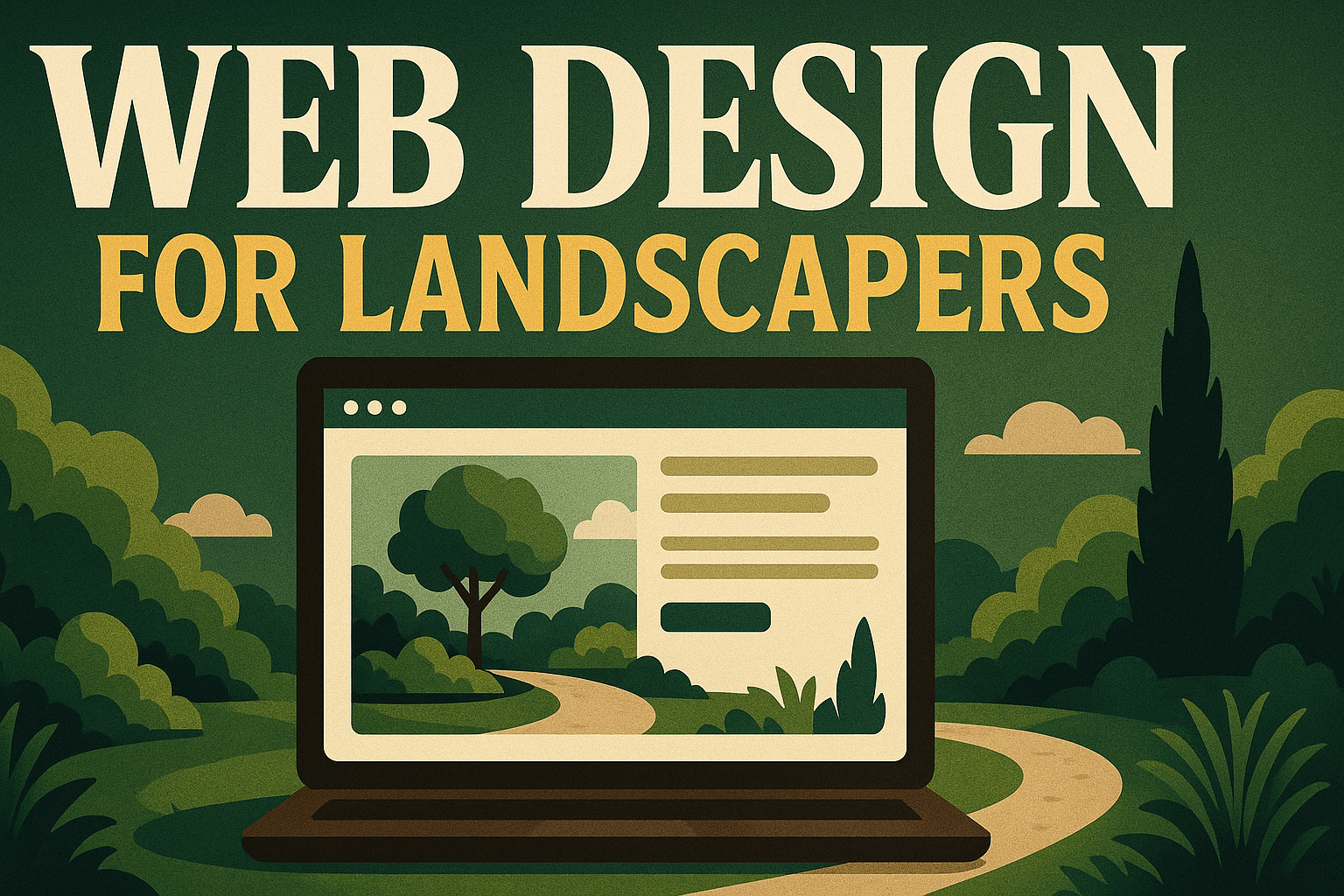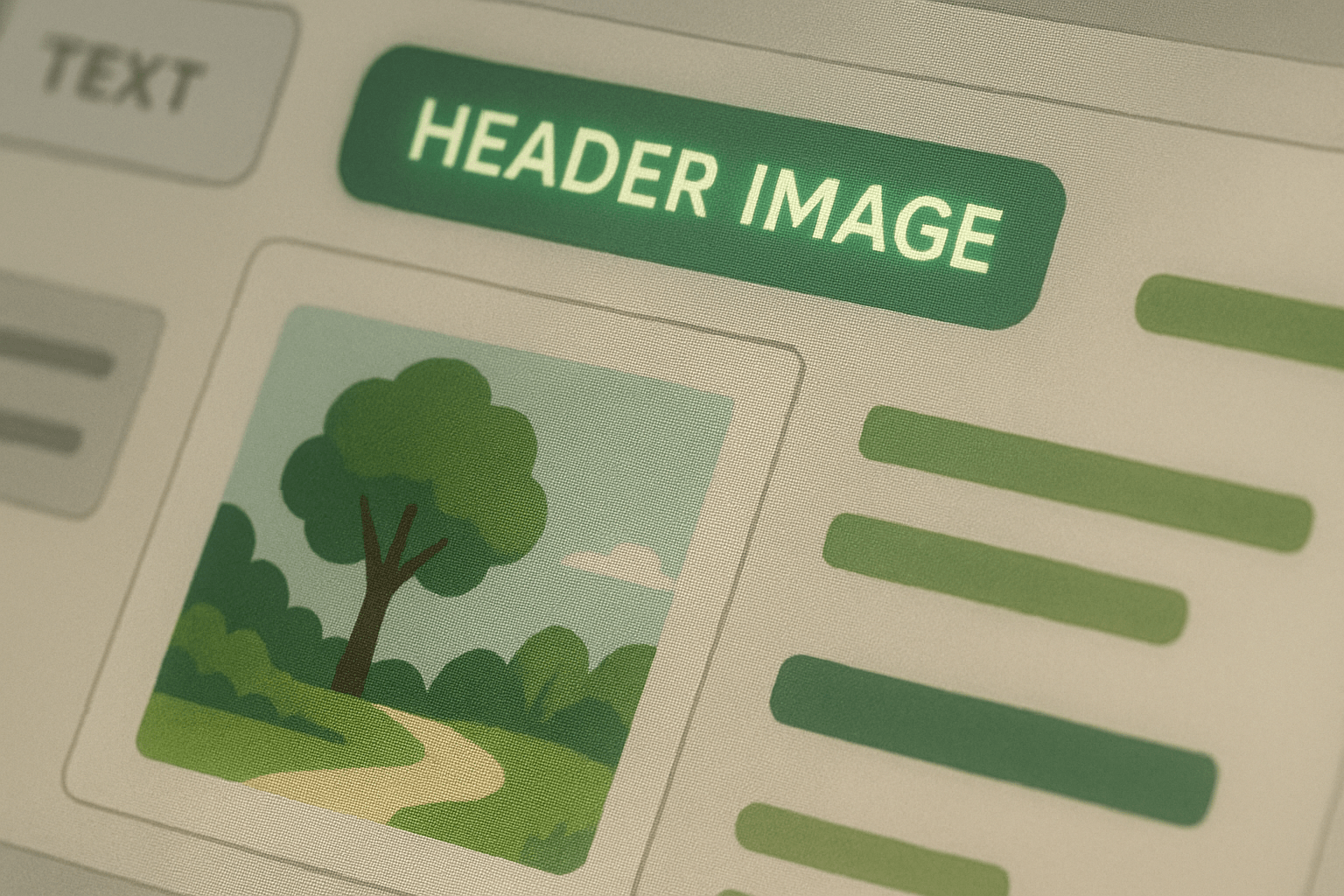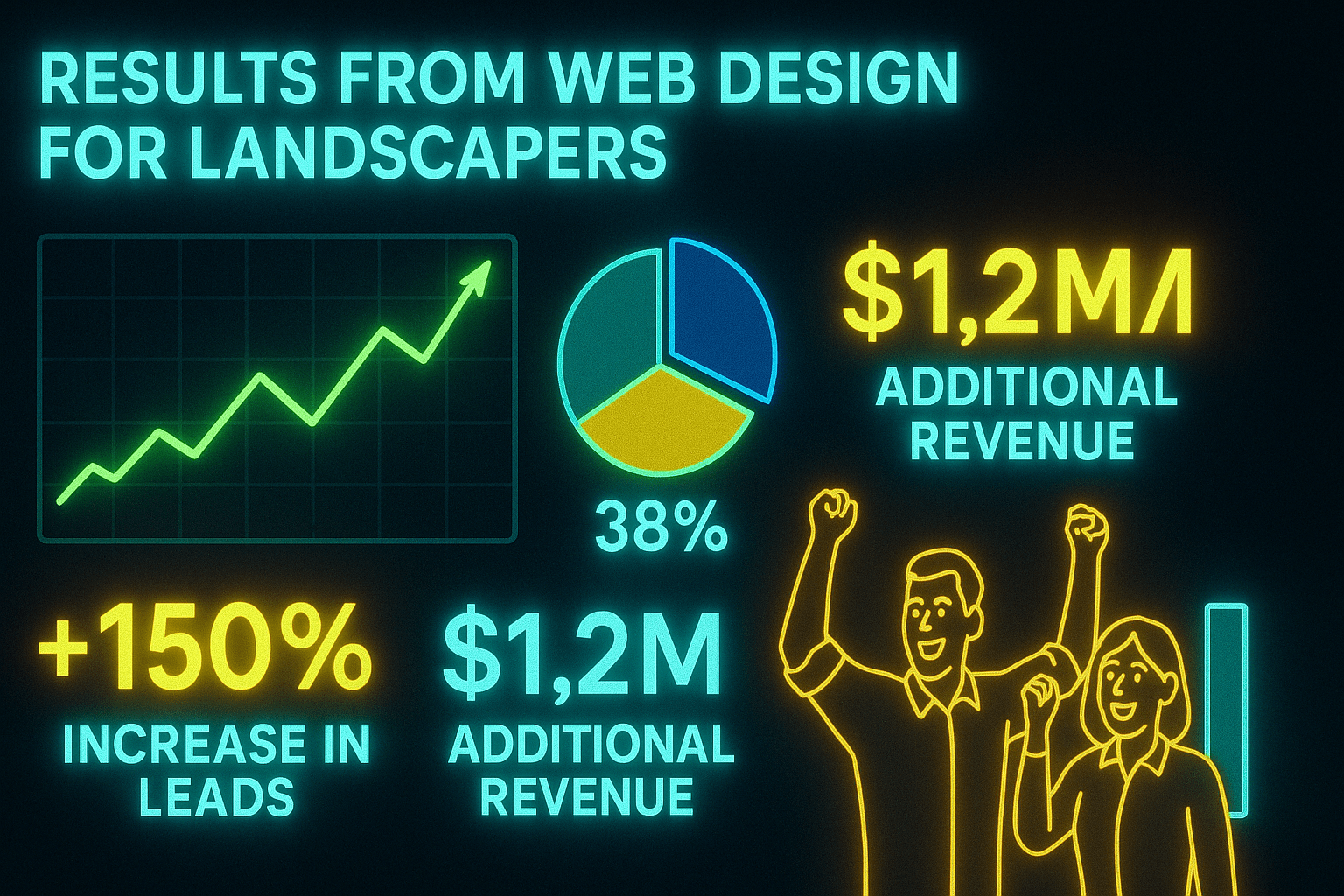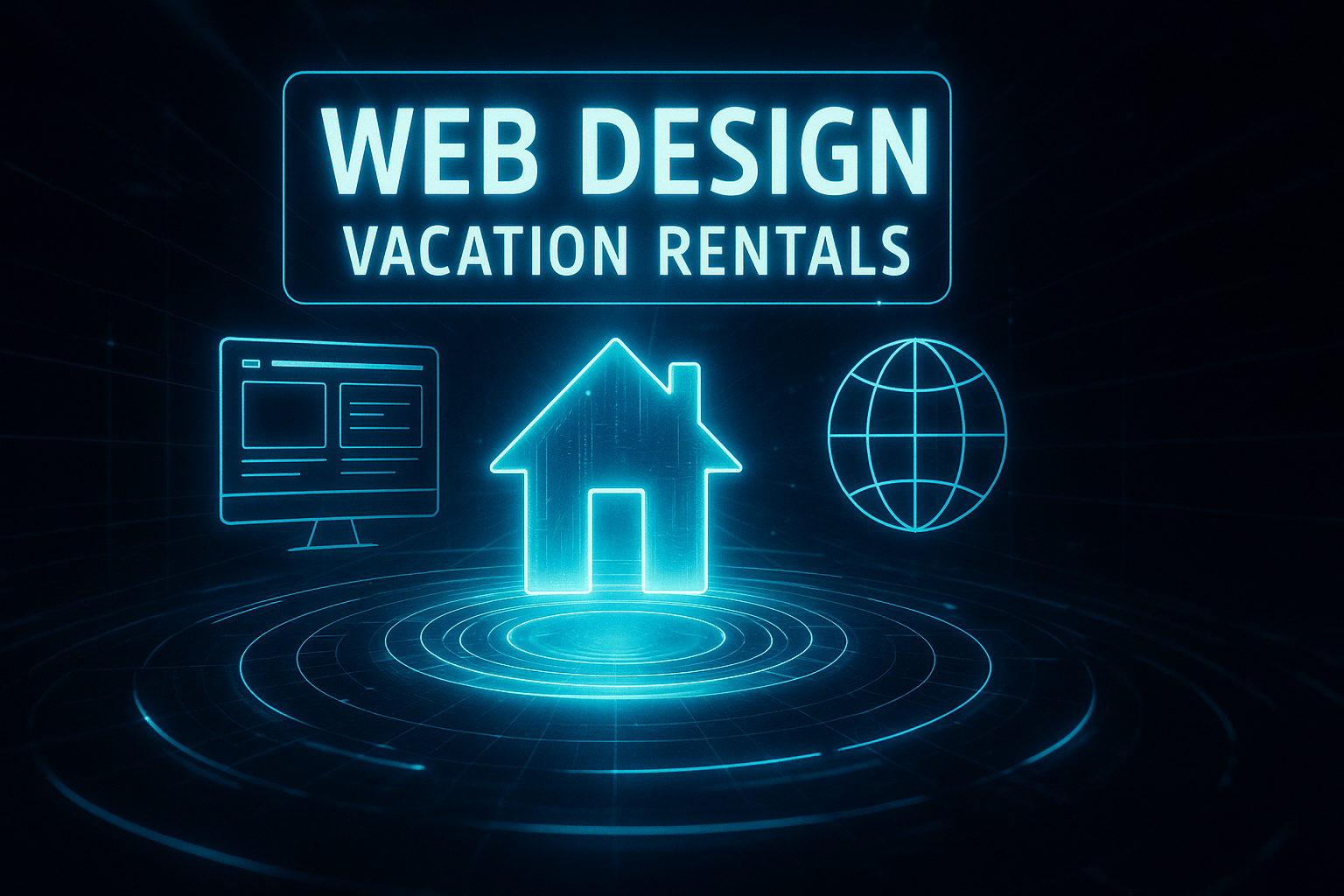Web Design for Landscapers: Complete 2026 Strategy Guide to Convert More Customers
by Design Delulu Editorial · October 17, 2025

Smart, fast, and measurable. Here's how web design helps Landscapers win.
In the competitive landscaping industry, your website serves as your digital storefront and most powerful sales tool. Homeowners and commercial property managers increasingly research landscaping services online before making contact, with studies showing that over 80% of potential clients visit a company's website before requesting a quote. A strategically designed website doesn't just showcase your beautiful garden transformations—it builds trust, demonstrates expertise, and converts casual browsers into qualified leads ready to invest in their outdoor spaces.
The landscaping business faces unique digital challenges that generic web design simply cannot address. Seasonal demand fluctuations require flexible content strategies. Visual portfolios must load quickly while maintaining image quality. Mobile optimization is critical since many homeowners browse while standing in their own yards, imagining possibilities. Service area targeting needs precise geographic focus. The right web design approach addresses these specialized needs while creating a seamless user experience that mirrors the quality and attention to detail clients expect from your landscaping work.

Why Professional Web Design Matters for Landscaping Companies
Your landscaping website functions as a year-round employee that never takes a day off. While traditional marketing methods like yard signs and local advertisements still have value, a professional website reaches potential customers at the exact moment they're searching for services. When someone types 'landscape designer near me' or 'lawn maintenance company' into their phone, your website needs to appear quickly, load instantly, and immediately communicate why they should choose your business over the competition.
First impressions happen in milliseconds. Research indicates that visitors form opinions about your credibility within 50 milliseconds of landing on your site. For landscaping companies, this means showcasing stunning project photography, clear service descriptions, and trust signals like customer reviews must be immediately visible. A cluttered, slow, or outdated website signals to potential clients that your landscaping services might be equally disorganized or behind the times.
Professional web design also directly impacts your bottom line through improved conversion rates. A well-structured site guides visitors through a logical journey: from discovering your services to viewing your portfolio, reading testimonials, understanding your process, and ultimately requesting a consultation or quote. Strategic placement of calls-to-action, intuitive navigation, and mobile-responsive layouts ensure that interested prospects can easily take the next step, regardless of which device they're using or what time of day they're browsing.
Beyond aesthetics and functionality, your website serves as the foundation for all digital marketing efforts. Search engine optimization, content marketing, social media campaigns, and paid advertising all drive traffic back to your website. If that destination fails to engage visitors or facilitate conversions, every marketing dollar spent becomes significantly less effective. Think of professional web design as the infrastructure that makes all other marketing investments more profitable.
Essential Web Design Elements for Landscaping Businesses
Visual Portfolio Presentation
The portfolio section is arguably the most critical component of any landscaping website. Potential clients need to see the quality and style of your work before they'll trust you with their property. However, high-resolution project photos can severely impact page load times if not properly optimized. Modern web design balances image quality with performance through techniques like lazy loading, responsive images, and next-generation formats such as WebP.
Organize portfolio projects strategically by service type, project scale, or property style to help visitors quickly find relevant examples. A commercial property manager looking for large-scale maintenance solutions wants different visual proof than a homeowner planning a backyard patio installation. Filtering and categorization options transform your portfolio from a simple image gallery into a powerful sales tool that speaks directly to each visitor's specific needs.
Include contextual information with each project: the client's original challenge, your creative solution, timeline, and measurable results when possible. Before-and-after image sliders create dramatic visual impact while demonstrating your transformative capabilities. Video content, when used selectively, can showcase complex installations or the seasonal evolution of planted landscapes in ways that static images cannot capture.
Service Pages That Convert
Each landscaping service you offer deserves a dedicated, well-optimized page. Generic 'Services' pages that list everything you do in bullet points fail to capture organic search traffic and don't provide enough information for serious buyers. Instead, create comprehensive pages for lawn maintenance, landscape design, hardscaping, irrigation systems, seasonal cleanups, and any other specialized offerings.
Effective service pages follow a consistent structure that addresses visitor intent at every stage:
- Clear value proposition: Immediately explain what the service is and who benefits from it
- Detailed process overview: Walk prospects through your methodology from consultation to completion
- Pricing transparency: Even if you can't provide exact quotes, offer ranges, packages, or factors that influence cost
- Relevant portfolio examples: Showcase 3-5 projects that specifically demonstrate this service
- Social proof: Feature testimonials from clients who used this particular service
- Geographic relevance: Mention specific neighborhoods, cities, or regions you serve
- Strong call-to-action: Make it easy to request a quote, schedule a consultation, or call immediately
Service pages also serve as primary landing pages for paid advertising campaigns. When someone clicks an ad for 'patio installation services,' they should land on a page specifically about patio installation, not your generic homepage. This message-match between ad copy and landing page content dramatically improves conversion rates while reducing advertising costs.
Mobile-First Design Approach
More than 60% of landscaping website traffic now comes from mobile devices. Homeowners browse while relaxing in their backyard, property managers check your credentials during site visits, and potential clients compare companies while commuting. If your website doesn't function flawlessly on smartphones and tablets, you're losing more than half your potential business.
Mobile-first design means building for small screens first, then enhancing the experience for larger displays—not simply shrinking a desktop site. This approach prioritizes essential content, simplifies navigation, and ensures tap targets are appropriately sized for fingers rather than mouse pointers. Click-to-call buttons should be prominent on mobile devices, recognizing that phone calls remain the preferred contact method for many service-based inquiries.
Page speed becomes even more critical on mobile networks. Compress images aggressively, minimize unnecessary scripts, and leverage browser caching to ensure pages load in under three seconds. Google prioritizes mobile page speed in search rankings, meaning slow mobile performance hurts both user experience and your visibility in search results. Tools like Google PageSpeed Insights provide specific recommendations for improving mobile performance.
Trust Signals and Credibility Markers
Landscaping represents a significant investment, and property owners need multiple reassurance points before they'll trust a company with their outdoor space. Strategic placement of trust signals throughout your website helps overcome natural skepticism and positions your business as the safe, reliable choice.
Key trust elements include:
- Customer reviews and testimonials: Feature authentic reviews prominently, including customer photos when possible
- Professional certifications: Display industry credentials, licenses, and insurance information clearly
- Years in business: Emphasize longevity and experience in your local market
- Award recognition: Showcase any industry awards, Best of Houzz honors, or local business accolades
- Association memberships: Display logos for professional organizations like NALP or state landscaping associations
- Service guarantees: Clearly communicate any workmanship guarantees or satisfaction policies
- Team introduction: Put faces to your business with professional photos and bios of key team members
These elements work together to create a comprehensive credibility profile. Don't hide them on an 'About' page that few visitors explore—integrate trust signals throughout your service pages, portfolio, and contact areas where they'll influence decision-making at critical moments.

Strategic Website Architecture for Maximum Impact
Information Hierarchy and Navigation
The way you structure and organize website content directly impacts both user experience and search engine optimization. Visitors should be able to find any information within three clicks from the homepage. Search engines should be able to crawl and understand your site structure to properly index and rank your content.
Start with a logical top-level navigation that reflects how customers think about landscaping services, not how you organize your internal operations. Most landscaping websites benefit from these primary navigation categories:
- Services: Dropdown menu listing all service categories with links to dedicated pages
- Portfolio or Projects: Showcase your work, often with filtering capabilities
- About: Company history, team, certifications, and service area
- Process: How you work with clients from consultation through project completion
- Resources: Blog, guides, seasonal tips, or other educational content
- Contact: Multiple ways to reach you, including quote request forms
Breadcrumb navigation helps visitors understand where they are within your site hierarchy and provides an easy way to navigate back to broader category pages. This seemingly small element significantly improves user experience on large sites with many service pages and portfolio projects.
Footer navigation offers a second opportunity to link to important pages while providing space for supplementary information like service areas, business hours, social media profiles, and privacy policies. Many visitors scroll directly to the footer when looking for contact information, so ensure phone numbers and location details are easily accessible there.
Conversion-Focused Page Design
Every page on your website should have a clear purpose and guide visitors toward a specific action. Whether that action is requesting a quote, calling your office, signing up for seasonal services, or downloading a planning guide, the path forward should be obvious and frictionless.
Apply these conversion optimization principles throughout your site:
- Above-the-fold clarity: Visitors should immediately understand what you offer and how to get started without scrolling
- Visual hierarchy: Use size, color, and whitespace to guide attention toward your most important messages and calls-to-action
- Reducing friction: Minimize form fields to only essential information; every additional field decreases completion rates
- Multiple contact options: Some people prefer phone calls, others forms, and some want to check availability via chat
- Strategic repetition: Don't make visitors hunt for contact buttons; repeat calls-to-action at logical points throughout longer pages
- Social proof near decisions: Place testimonials and reviews near quote forms to provide final reassurance
Test different call-to-action language to find what resonates with your audience. 'Get Your Free Quote' typically outperforms generic 'Contact Us' buttons. 'Schedule a Consultation' may work better for high-end landscape design services than 'Request Information.' Small wording changes can produce significant conversion rate improvements.
Local SEO Integration
For landscaping companies, local visibility determines business success. You're not competing nationally—you're competing for customers within your specific service radius. Website design must incorporate local SEO strategies from the foundation, not as an afterthought.
Location-specific pages help you rank for searches in each city or region you serve. Create dedicated pages for major service areas that include local landmarks, neighborhood references, and area-specific content. Avoid creating duplicate pages with only city names changed; each location page needs unique, valuable content about serving that specific area.
Schema markup tells search engines exactly what your business does, where you operate, and how to display your information in search results. Implement LocalBusiness schema with complete NAP (Name, Address, Phone) information, service area specifications, and business hours. Review schema displays star ratings directly in search results, increasing click-through rates when potential clients see your high ratings before even visiting your site.
Your Google Business Profile and website must present consistent information. Discrepancies between your listed business name, address, or phone number across platforms confuse search engines and hurt local rankings. Ensure your website footer displays exactly the same NAP information as your Google Business Profile, directory listings, and citation sources.
Content Strategy for Landscaping Websites
Educational Content That Builds Authority
Positioning your landscaping company as the local expert requires more than just showcasing completed projects. Educational content demonstrates knowledge, builds trust, and captures organic search traffic from people researching landscaping topics before they're ready to hire a contractor.
Develop content around the questions your customers actually ask:
- Best plants for shade in [your climate zone]
- How to prepare your lawn for winter
- Permeable paving options for driveways
- Native plants that attract pollinators
- Landscape lighting design principles
- Irrigation system maintenance schedule
- When to schedule seasonal landscaping services
Long-form guides (1,500+ words) targeting specific topics attract backlinks from local bloggers, generate social shares, and provide comprehensive value that keeps visitors on your site longer. These cornerstone pieces establish topical authority while supporting your service pages through internal linking.
Seasonal content capitalizes on predictable annual interest patterns. Publish spring cleanup guides in late winter, summer drought-tolerance articles in May, fall planting advice in August, and winter preparation content in October. This content stays relevant year after year with minor updates, providing ongoing traffic value from a one-time content investment.
Visual Storytelling Through Project Case Studies
Transform simple portfolio entries into compelling case studies that walk potential clients through your problem-solving process. Instead of just showing beautiful finished photos, tell the complete story: the client's challenge, site constraints, your design solution, implementation details, and the final result's impact on the property and owners.
Effective case studies answer the questions prospects have:
- What was the timeline? Set realistic expectations about how long similar projects take
- What was the investment? Even general price ranges help prospects self-qualify and understand value
- What challenges arose? Discussing obstacles and solutions demonstrates experience and transparency
- How has it performed? Follow-up photos showing seasonal changes or long-term results build confidence
Include client testimonials within case studies to provide authentic perspective on what working with your company is actually like. Quote clients discussing their decision-making process, their experience during installation, and their satisfaction with the results. This narrative approach creates emotional connection while demonstrating technical expertise.
Video Content Integration
Video content increases engagement and time-on-site while providing information in a format many users prefer. Landscaping lends itself naturally to video through time-lapse project documentation, before-and-after reveals, plant care tutorials, and seasonal maintenance advice.
Keep videos focused and concise. Attention spans are short, especially for online video. Aim for 60-90 seconds for social media clips and 2-4 minutes for educational content. Longer videos work for detailed design consultations or complex project documentation, but ensure they're well-edited and maintain pacing.
Optimize video hosting for performance. While YouTube provides discoverability benefits, self-hosted video or platforms like Vimeo often provide better user experience without distracting suggestions for competitor content. Implement lazy loading so videos don't impact initial page load times. Always include transcripts or captions for accessibility and SEO value.

Performance Optimization and Technical Excellence
Core Web Vitals and Page Speed
Google now considers page experience signals, including Core Web Vitals, as ranking factors. These metrics measure loading performance, interactivity, and visual stability—all critical factors for user experience and conversion rates. Landscaping websites, with their image-heavy portfolios, face particular challenges in meeting these performance standards.
Largest Contentful Paint (LCP) measures how quickly the main content loads. Target under 2.5 seconds. Optimize by compressing images, using modern formats like WebP, implementing a content delivery network (CDN), and minimizing render-blocking resources. Your hero image and portfolio thumbnails are typically LCP elements, so prioritize their optimization.
First Input Delay (FID) measures responsiveness when users try to interact with your page. Keep FID under 100 milliseconds by minimizing JavaScript execution time, breaking up long tasks, and using web workers for heavy computations. Avoid bulky page builders or excessive plugins that load unnecessary scripts.
Cumulative Layout Shift (CLS) measures visual stability as the page loads. Aim for a score under 0.1. Prevent layout shifts by specifying dimensions for images and video embeds, avoiding dynamically injected content above existing content, and reserving space for ad slots or embeds before they load.
Regular performance auditing with tools like Google PageSpeed Insights, GTmetrix, or WebPageTest identifies optimization opportunities. Address the highest-impact issues first, focusing on mobile performance where most visitors experience your site. Even small performance improvements can yield measurable increases in engagement and conversion rates.
Accessibility Standards and Inclusive Design
Accessible web design isn't just ethically important—it's legally required in many jurisdictions and expands your potential customer base. Web Content Accessibility Guidelines (WCAG) provide standards for making websites usable by people with various disabilities, and following these guidelines simultaneously improves overall usability for everyone.
Implement these essential accessibility practices:
- Color contrast: Ensure text has sufficient contrast against backgrounds (minimum 4.5:1 ratio for normal text)
- Alternative text: Provide descriptive alt text for all portfolio images and informational graphics
- Keyboard navigation: All interactive elements must be accessible via keyboard alone, without requiring a mouse
- Form labels: Every form field needs a clear, associated label, not just placeholder text
- Heading hierarchy: Use heading tags (H1, H2, H3) in proper order to create logical document structure
- Link clarity: Avoid vague link text like 'click here'; make links descriptive and contextual
- Focus indicators: Ensure keyboard users can see which element currently has focus
Accessibility overlays and widgets that claim to make sites compliant with a simple code snippet are generally insufficient and may create new problems. True accessibility requires thoughtful design and development from the start, not a superficial plugin added afterward.
Security and Maintenance Protocols
Your website handles sensitive customer information through contact forms and quote requests. Implementing proper security measures protects both your clients and your business reputation. An SSL certificate (HTTPS) is non-negotiable—it encrypts data transmission and is also a confirmed ranking factor for Google.
Regular backups protect against data loss from security breaches, server failures, or accidental deletions. Automated daily backups with off-site storage provide peace of mind and quick recovery options if something goes wrong. Test your backups periodically to ensure they actually work when needed.
Keep your content management system, themes, and plugins updated. Security vulnerabilities are regularly discovered and patched, and running outdated software makes your site an easy target for automated attacks. If you're not comfortable managing technical updates yourself, a maintenance plan with your web design agency or hosting provider ensures these critical tasks happen consistently.
Marketing Integration and Lead Generation
CRM and Email Marketing Connections
Your website should seamlessly integrate with your customer relationship management (CRM) system and email marketing platform. When a prospect submits a quote request, that information should automatically flow into your sales pipeline without manual data entry. This integration speeds up response times, reduces errors, and ensures no leads slip through organizational cracks.
Email capture strategies build your marketing database for nurturing prospects who aren't ready to commit immediately. Offer valuable content in exchange for email addresses:
- Seasonal landscaping checklist downloads
- Native plant selection guides for your region
- Landscape design inspiration lookbooks
- Budget planning worksheets for outdoor projects
Automated email sequences can nurture these leads over time, providing additional value through educational content, seasonal reminders, and special offers until prospects are ready to request services. This long-term nurturing approach recognizes that major landscaping projects often involve months of planning before customers are ready to move forward.
Social Proof and Review Integration
Online reviews significantly influence purchasing decisions, particularly for local services where quality and reliability are paramount. Your website should actively showcase positive reviews from multiple platforms while making it easy for satisfied customers to leave new reviews.
Implement review widgets or integrations that pull current reviews from Google, Facebook, Houzz, or Yelp directly onto your site. Fresh reviews signal active business and recent customer satisfaction. However, be selective about which platforms you emphasize—focus on the review sites that matter most in your local market and industry.
Video testimonials provide the most powerful social proof. Hearing satisfied customers describe their experience in their own words creates authenticity that written reviews can't match. Keep these videos short (60-90 seconds), focus on specific results and experiences, and use them prominently on your homepage and service pages.
Respond to all reviews, both positive and negative, professionally and promptly. Detailed responses to negative reviews demonstrate your commitment to customer satisfaction and often impress prospects more than the negative review itself harmed you. Embed this review management process into your regular business operations.
Analytics and Conversion Tracking
Data-driven decision making separates thriving landscaping businesses from those that struggle. Comprehensive analytics tell you which marketing channels drive traffic, which pages convert visitors to leads, and where potential customers drop off before contacting you.
Set up goal tracking for all valuable actions:
- Quote request form submissions
- Phone calls from click-to-call buttons
- Email address opt-ins
- Service page visits
- Portfolio interaction
- Resource downloads
Use UTM parameters to track traffic sources precisely. When you share content on social media, run email campaigns, or place offline advertising, tagged links tell you exactly which efforts produce results. This attribution data helps you allocate marketing budgets toward the channels that actually generate customers, not just website traffic.
Conversion rate optimization is an ongoing process. Use tools like heatmaps and session recordings to understand how visitors actually interact with your site. Where do they click? How far do they scroll? Where do they abandon forms? These behavioral insights reveal optimization opportunities that surveys and focus groups cannot provide.
Choosing the Right Web Design Partner
Agency vs. Freelancer vs. DIY Platforms
Landscaping companies face several options for creating their website, each with distinct advantages and tradeoffs. Template-based DIY platforms like Wix or Squarespace offer affordability and quick setup but lack customization flexibility and often produce inferior performance and SEO results. These solutions work for very small operations or those just starting out, but growing businesses quickly outgrow their limitations.
Freelance web designers typically offer more customization and lower costs than agencies but may lack diverse skill sets. A talented designer might not be equally skilled in development, SEO, content strategy, or conversion optimization. Project timelines can also be unpredictable if you're one of many clients competing for attention.
Professional web design agencies provide comprehensive teams with specialized expertise in strategy, design, development, content, SEO, and analytics. Projects follow defined processes with accountability measures and timeline commitments. However, agencies command premium pricing and may have minimum project sizes that exceed small company needs or budgets.
Consider your priorities: speed to launch, budget constraints, customization requirements, technical complexity, ongoing support needs, and marketing integration sophistication. The right choice depends on your specific situation, growth trajectory, and available resources.
Essential Questions to Ask Prospective Designers
Vetting potential web design partners requires asking specific questions that reveal their approach, experience, and compatibility with your business goals. Don't just review portfolios—dig deeper into how they work and what results they deliver:
- Industry experience: Have they worked with other landscaping companies or similar service businesses?
- Performance metrics: Can they share case studies with measurable improvements in traffic, leads, or conversions?
- Design process: How many revision rounds are included? What does their feedback and approval process look like?
- Timeline expectations: What's the realistic project duration from kickoff to launch?
- Content strategy: Do they provide content writing services or expect you to provide all text?
- SEO approach: How do they handle technical SEO, keyword research, and on-page optimization?
- Mobile optimization: How do they ensure excellent mobile experiences across devices?
- Hosting and maintenance: What ongoing support is included? What are long-term hosting costs?
- Analytics setup: Do they configure tracking and provide training on using analytics data?
- Ownership: Will you own all design files, content, and code after project completion?
Request references from past clients in similar industries. Speak directly with these references about their experience, whether the project stayed on budget and schedule, how the designer handled challenges, and whether the final product achieved desired results.
Budget Planning and ROI Expectations
Professional landscaping websites typically range from $5,000 to $25,000+ depending on complexity, customization, content requirements, and agency expertise. Template-based sites cost less but deliver less. Highly customized sites with advanced functionality cost more but provide greater competitive advantages.
View web design as an investment rather than an expense. A well-designed website that generates just one additional high-value project per month can pay for itself many times over within the first year. Calculate potential ROI by estimating how many additional leads a professional site might generate and converting those leads into revenue at your average project value and close rate.
Budget for ongoing optimization beyond the initial launch. Allocate resources for content updates, seasonal landing page creation, A/B testing, and performance refinement. Websites aren't set-it-and-forget-it assets—they require continuous improvement to maintain and enhance results over time.
Consider phased approaches if budget is constrained. Launch with essential pages and functionality first, then add advanced features, expanded content, and enhanced integrations as revenue grows. This approach gets you online quickly while leaving room for evolution as your business and marketing sophistication develop.
Future-Proofing Your Landscaping Website
Emerging Design Trends and Technologies
Web design evolves constantly, but not every trend deserves implementation. Focus on innovations that genuinely improve user experience or business results rather than following trends for their own sake. Several emerging approaches show particular promise for landscaping businesses looking to differentiate their digital presence.
Interactive design tools let prospects visualize possibilities before committing to consultations. Plant selection quizzes help homeowners identify suitable species for their conditions. Budget calculators provide rough project estimates. Design style assessments guide customers toward services matching their aesthetic preferences. These tools increase engagement while qualifying leads more effectively than passive content alone.
Augmented reality (AR) capabilities are becoming more accessible, allowing prospects to visualize landscape designs in their actual space using smartphone cameras. While still emerging, this technology addresses a primary customer challenge—imagining how proposed designs will look in reality. Early adopters gain competitive differentiation, though implementation requires careful consideration of user adoption barriers and technical capabilities.
Voice search optimization grows increasingly important as smart speakers and voice assistants become ubiquitous. Structure content to answer conversational questions people actually ask. Featured snippet optimization helps your content appear in voice search results when prospects ask questions like 'What's the best landscaping company near me?' or 'How much does landscape design cost?'
Scalability and Growth Considerations
Your website architecture should accommodate business growth without requiring complete rebuilds. Plan for expansion from the beginning, even if you're currently a small operation. Consider these scalability factors:
- Service expansion: Can you easily add new service pages as you expand offerings?
- Geographic growth: Does your structure support adding location pages as you enter new markets?
- Team growth: Can team member profiles scale from a handful to dozens as you hire?
- Portfolio volume: Will your portfolio system handle hundreds or thousands of projects without performance degradation?
- Content library: Does your blog or resource center support extensive content development?
- Multilingual capability: If you serve diverse communities, can the site support multiple languages?
Choose content management systems and hosting environments that scale with your needs. WordPress, for example, powers everything from small local businesses to major media companies. The platform itself isn't a limitation—implementation quality determines scalability and performance.
Sustainability and Long-Term Maintenance
The most beautifully designed website provides little value if it becomes outdated or insecure within months. Establish clear maintenance protocols and responsibilities to keep your digital presence fresh, secure, and effective over time.
Create a content calendar for regular updates:
- Quarterly: Review and update service pricing, add new portfolio projects, refresh seasonal content
- Monthly: Publish new blog content, update promotions or special offers, review and respond to new testimonials
- Weekly: Monitor analytics, respond to contact form submissions, update homepage imagery
- Daily: Monitor site functionality, respond to customer inquiries
Annual website audits identify technical issues, broken links, outdated content, performance problems, and optimization opportunities before they significantly impact results. Schedule these comprehensive reviews during your slow season when you can dedicate attention to implementing recommendations.
Document your website's architecture, custom functionality, and update procedures. If team members change or you transition to a new web design partner, this documentation ensures continuity and prevents knowledge loss. Include login credentials, hosting details, domain registrar information, and vendor contacts in a secure, accessible location.
Frequently Asked Questions
Let’s level up your Landscapers business
Need services that actually move the needle for Landscapers? See our approach, pricing, and timelines—then book a quick call.
Additional Resources
- Schedule Your Free Web Design Consultation
Book a 30-minute strategy call to discuss your landscaping business goals, current website challenges, and how professional web design can increase your leads and revenue.
- View Our Landscaping Web Design Portfolio
Explore completed landscaping website projects showcasing our design approach, conversion optimization strategies, and measurable results for companies like yours.
- Access Free Landscaping Marketing Tools
Download complimentary resources including website audit checklists, SEO keyword planners, conversion rate calculators, and content planning templates designed specifically for landscaping businesses.
Related Reading

Transform your vacation rental website with conversion-focused design. Discover proven strategies, booking optimization, and responsive layouts that increase direct reservations.

Discover how strategic web design helps cleaning companies attract customers, showcase services, and convert website visitors into loyal clients. Proven design strategies inside.
